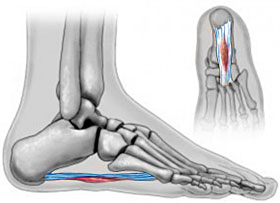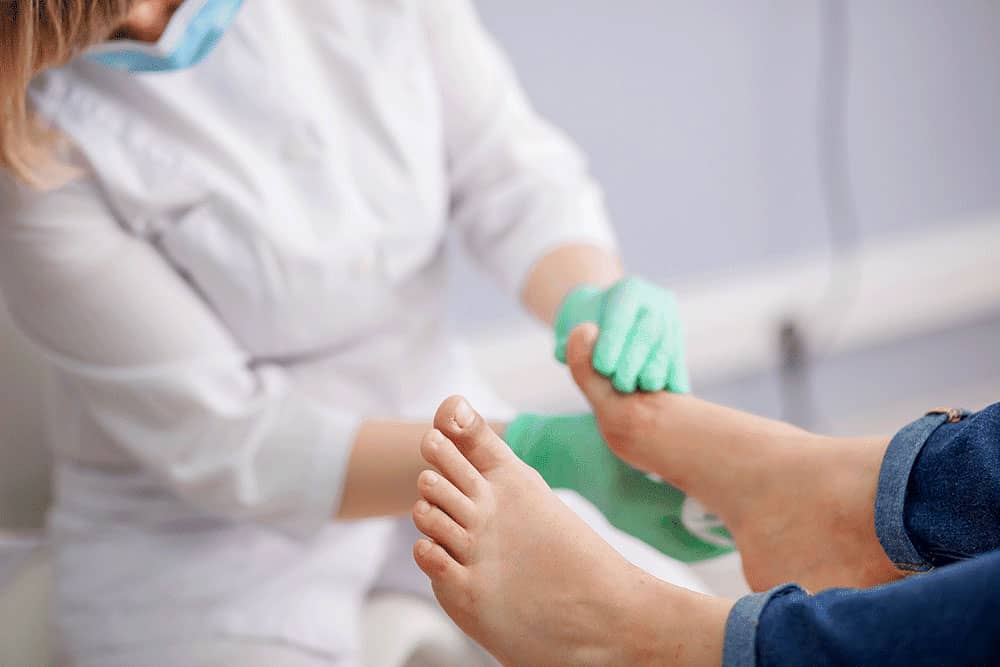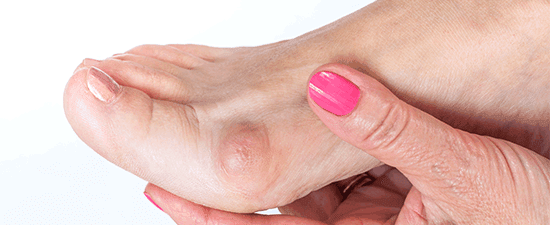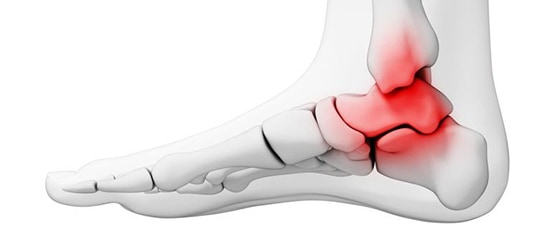- Home
- Foot & Ankle Conditions
- Cysts
- Plantar Fibroma Cysts
Plantar Fibroma Cysts: symptoms, causes and treatments

What's a Plantar Fibroma Cyst?
A plantar fibroma is a knot of connective tissue in the arch of your foot, buried deep within the plantar fascia (the band of tissue that runs from the heel to the forefoot along the bottom of the foot). Also known as Ledderhose disease, a plantar fibroma nodule is made up of the same type of tissue that is found in ligaments.
A plantar fibroma is slow-growing and may develop on the sole of one or both feet. Luckily, these tumors are non-cancerous.
However, the mass usually will not go away without treatment. It's critically important that you have a proper evaluation of cysts that you discover to eliminate a more serious medical condition (such as cancer).
The condition is diagnosed most in the middle-aged and elderly population. Risk factors include diabetes, chronic liver disease, and epilepsy.
- What are the symptoms of a plantar fibroma cyst?
- What causes plantar fibroma?
- How to diagnose plantar fibroma
- What are plantar fibroma treatment options?
- University Foot & Ankle Institute (UFAI) is the best choice for plantar fibroma treatment
- How serious is plantar fibroma?
- Is it OK to massage plantar fibroma?
- Is walking bad for plantar fibroma?
- What will happen if you don't get rid of a plantar fibroma?
- Is plantar fibroma hereditary?
-
Foot and Ankle Surgeon at University Foot and Ankle Institute
Dr. Charles Kelman, DPM, is Board Certified by the American Board of Podiatric Surgery, as well as a Fellow of the America’s College of Foot and Ankle Surgeons. After attending California College of Podiatric Medicine, Dr. Kelman took his residency at Monsignor Clement Kern Hospital in Warren, Michigan.
Dr. Kelman, who entered into practice in 1980, specializes in forefoot surgery, sports medicine and rheumatology. He has volunteered as a Clinical Instructor at the Northridge Family Practice Residency Program since 1989. Dr. Kelman also donates his time at the Westminster Free Clinic.
Read Our Blog Articles About Cysts and Warts
 Professional and personable interchanges made me feel comfortable and understoodApril W.
Professional and personable interchanges made me feel comfortable and understoodApril W. Dr is very caring and smart. She made me feel very comfortable and explained everything to me.Anso K.
Dr is very caring and smart. She made me feel very comfortable and explained everything to me.Anso K. Great experience. Great communication. Great direction for my care. Very happy I chose to go with this particular doctor and o...Christopher R.
Great experience. Great communication. Great direction for my care. Very happy I chose to go with this particular doctor and o...Christopher R. Great service and care. Highly recommend Dr. Franson.David B.
Great service and care. Highly recommend Dr. Franson.David B. If you have to go see a Doctor than this is a great experience.Frank M.
If you have to go see a Doctor than this is a great experience.Frank M. It was a very good overall experience. Glad I found them.Tracy T.
It was a very good overall experience. Glad I found them.Tracy T. My doctor was great. Really greatRudolph B.
My doctor was great. Really greatRudolph B. Good.David E.
Good.David E. Your Santa Barbara office and Dr. Johnson always give me excellent care!Jayne A.
Your Santa Barbara office and Dr. Johnson always give me excellent care!Jayne A. Dr. Gina Nalbadian was amazing!! I came in with an emergency foot situation and she had wonderful bedside manner and resolved m...Danielle C.
Dr. Gina Nalbadian was amazing!! I came in with an emergency foot situation and she had wonderful bedside manner and resolved m...Danielle C. I was frustrated that after 3 weeks I still hadn’t heard back about my PT referral status. And I did sit in a room for over 30 ...Sarah C.
I was frustrated that after 3 weeks I still hadn’t heard back about my PT referral status. And I did sit in a room for over 30 ...Sarah C. I’m very pleased with Dr. Kelman.Alan S.
I’m very pleased with Dr. Kelman.Alan S.
-
 Listen Now
What is Synovial Sarcoma? A Rare and Dangerous Cancer
Read More
Listen Now
What is Synovial Sarcoma? A Rare and Dangerous Cancer
Read More
-
 Listen Now
11 Common Foot Lumps and Bumps and What To Do About Them
Read More
Listen Now
11 Common Foot Lumps and Bumps and What To Do About Them
Read More
-
 Listen Now
Expert Insights On Treatment Options For Cystic Lesions Of The Talus
Read More
Listen Now
Expert Insights On Treatment Options For Cystic Lesions Of The Talus
Read More
-
 This foot condition is the new back pain — it’s everywhere. UFAI in the News.
Read More
This foot condition is the new back pain — it’s everywhere. UFAI in the News.
Read More




